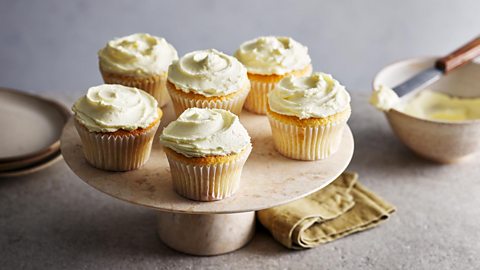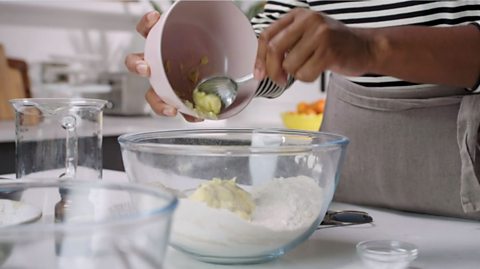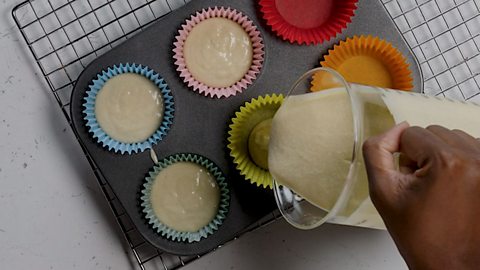Why making your cake backwards is less crazy than it sounds
The reverse creaming method is a foolproof way to bake cakes, and it’ll even save you on pricey butter. Here's how to use it to create perfect cupcakes.

Cupcakes are just the thing for life’s little celebrations. Playful and cheerful, topped with a generous swirl of buttercream and maybe a scattering of sprinkles, they can’t fail to make you smile. There’s also something pretty indulgent about having a perfectly formed mini cake all to yourself.
If you’ve never made them – or never been happy with the results – I have a method that will have you turning out perfect, fluffy, tender cupcakes every time.
What is reverse creaming?

Ninety percent of sponge cake recipes will start with creaming butter and sugar together, adding eggs and flavouring, then folding in flour to make a relatively stiff batter. The goal of all that beating is to incorporate lots of air into the butter, so then you need to try and integrate the eggs and flour without knocking all those tiny bubbles flat.
My method is a little different: I use the reverse creaming technique (pioneered by American food writer, Rose Levy Beranbaum). It may feel a little counter-intuitive, but it’s perfect for beginner bakers and kids because it's so reliable.
With the usual creaming method, there’s the risk that the batter will curdle when the eggs are added – the watery eggs and the butter often fail to combine smoothly. You may have seen your batter look grainy if you’ve added cold eggs or added them too quickly. The result is a heavier, denser (albeit still perfectly edible) sponge.
With the reverse creaming technique, you start by beating the butter into the flour and other dry ingredients to create a sandy powder, and then add the liquids (milk, eggs and vanilla). Coating the flour in the butter limits the gluten development (which is what leads to a tough or rubbery cake) and also eliminates the possibility of curdled batter.
There’s another benefit to this method too: it tends to use a lot less butter than a traditional sponge. I’m talking less than half the amount. This brings down the cost (quite considerably, given how much butter costs right now) as well as the fat content.
Related stories
How to make a reverse-creamed cake
The most important tip for this method is to make sure your butter is soft when you start. Really soft. If you try to beat it in cold butter, you will end up with a snow scene of flour in your kitchen. More importantly though, you need the butter to be soft enough to properly coat the flour so that it can, as mentioned, prevent gluten forming.
You don’t need to beat it as long as you would when creaming butter and sugar together – you just want to disperse it through the flour until it looks like fine sand. If you don’t have a freestanding mixer, a hand-held mixer will work fine – but use a big bowl to stop it flying around.
Once you’ve mixed all your wet ingredients together, you can add it all at once to the dry ingredients and give everything a good mix for a minute to get some air bubbles into the mixture.

The end result is fluffy, tender and soft, rather than dry and airy. And the reverse creaming method gives a level, flat top, rather than a domed top, which is why I like to choose this technique for cupcakes – it makes them much easier to decorate.
This batter might seem a little runnier than you’re used to but, rest assured, this will translate to a lovely light sponge.
Flavouring
I love to incorporate unanticipated ingredients into my cakes, but sometimes a really good vanilla sponge hits the sweet spot. Vanilla is, I think very unfairly, often dismissed as being boring (despite being the second most expensive spice in the world). Because this cupcake contains less butter and therefore less buttery flavour, adding a little vanilla will help it along.
Vanilla bean paste is a mixture of vanilla powder and extract, and it incorporates little specks of the vanilla pod. Meanwhile, extract is made by soaking whole beans in a mixture of water and alcohol. Either will work fine, although paste imparts a slightly more intense flavour, so if you use extract you might need a dash more.
The grated zest of an orange or lemon – or even a lime – would work really well to add some subtle citrussy flavour, and you can substitute the milk for buttermilk if you want more of a tang.
Icing and filling
Everyone associates cupcakes with a giant spiral of buttercream, but there are many other options you can try.
You can ice your cupcakes simply using a palette knife: blob on a good mound of icing and smooth down, then use your knife to make a little indent. You can then fill your indent with whatever you fancy – I use blueberries, raspberries, chopped pistachios and, of course, sprinkles.
Filling your cupcakes is an extra surprise treat: chocolate spread, strawberry jam, lemon curd or peanut butter work really well. For something fresher you could try macerated raspberries (perfect with a white chocolate buttercream). Or if you’re baking with kids, you could fill them with tiny sweets like little edible piñata cakes. A reverse creamed cupcake is sturdy enough to take it.
To add a filling, take a small sharp knife and cut a cone shape out of the sponge – you want to go about three-quarters of the way down. Go too far and the filling will spill out, but you do need a large enough hole for the filling to have an impact. Depending on your filling, you might want to pipe it in with a medium nozzle, although a teaspoon will work just as well. You can even add two different fillings if you’re feeling creative!
You can trim the piece of sponge you cut out and replace it to create a lid before icing if you like, although I prefer to leave them off (and use them for testing!) and just pipe the icing straight on.
I’ve long been enthralled with the magic of baking, it’s a wonderful world to immerse yourself in and you simply can’t go wrong with this cupcake recipe. A plateful of cupcakes is always a welcome addition to any occasion, and with this method they will be light and fluffy every time.
Now make:
Originally published March 2023